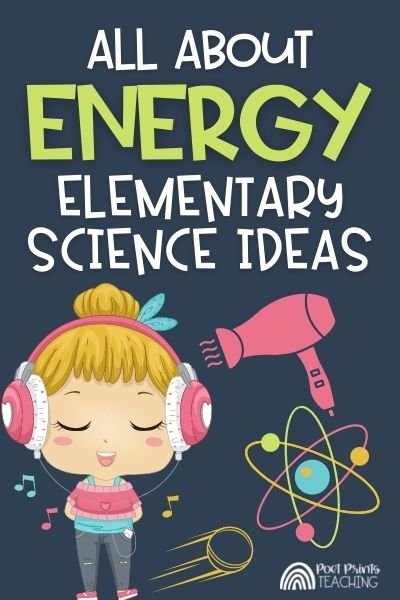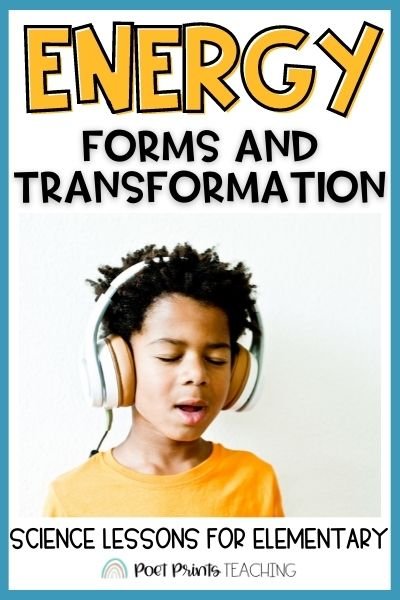Activities to Teach Forms of Energy and Energy Transformation
Energy is a magnificent thing. It is something adults all wish we had more of and children seem to have an endless supply of. And yes, this is very true, but I’m talking about energy in terms of science. Teaching students about the forms of energy can lead to some pretty engaging lessons. So let’s check out four types of energy lessons.
What is the Law of Conservation of Energy?
The Law of Conservation of Energy is a law stating that energy can be changed, but it cannot be created or destroyed. Energy can change from one form to another, but energy is never lost during this transformation process.
A Complete Energy Unit is Here!
Learn all about Forms of Energy and Energy Transfer with this one hands-on unit that has everything you need.
Scripted lessons… check!
Reading Passages… check!
Hands-on projects and stations… check!
Vocabulary and Assessment… check check!
Take the planning off of your plate and grab all ten scripted lessons here…
What are the Types of Energy?
The exact number of energy types is a bit open for interpretation, but here are some of the most common types of energy:
kinetic energy
light energy
sound energy
thermal energy
elastic energy
nuclear energy
chemical energy
magnetic energy
gravitational energy
electrical energy.
Energy is all around us and we use it every day.
Types of Energy Videos
I love introducing new concepts by showing video clips and here are some great videos about energy.
Dr. Binocs is a classic science YouTube channel that many teachers use for introducing science topics. This short video goes over a few of the most common types of energy. It also delves into the concept of potential energy.
This video also gives a good overview of energy. It categorizes energy into two main areas: potential energy and kinetic energy. Then the video delves into the different types of energy.
If you’re looking for a video that’s a little longer, you might love this Bill Nye the Science Guy video about energy. Did you watch Bill Nye as a kid? This video sure does bring back memories from my childhood!
Hands-On Energy transformation Stations
These hands-on stations teach students all about how energy transfers from one form to another. (Bonus: they’re super easy to set up!)
Who doesn't love some good hands-on science stations? During this part of the study of forms of energy, students will complete four student-led stations, each designed to teach about energy in a hands-on way.
Each station has an engaging activity to determine the energy input and output. It’s such a fun way for kids to see how energy transforms from one form to another.
Station One - Roll a marble down a printable track.
Station Two - Turn on a flashlight and activate a glow stick.
Station Three - Take your temperature with a contactless thermometer before and after exercise.
Station Four - Watch a bowl of sprinkles ‘dance’ when you play loud music next to them.
Project-Based Learning: Energy Machines
Project-based learning is a great way to cap off a science unit. They can check for student understanding without having to make students sit down for a timed test (that doesn’t always show understanding anyways!)
In this project, students will have the opportunity to design and build an Energy Machine.
This machine will have the power to transform energy into different forms. As a simple example, some students might build a machine that uses a hair dryer to melt a piece of chocolate. (In this example, electric energy transforms into heat energy!)
Students will create a blueprint, gather materials and build a prototype to show their classmates. Not only is this project a fun way for students to demonstrate their learning, it is also a great way for them to use their creativity!
The full instructions, planning pages, and assessment rubric are included in the Energy Unit.
even more Energy Experiments
There are SO many experiments that you could do with your class to demonstrate the various types of energy. So let’s take a look at a few types of energy activities:
Magnets: Give students magnets and have them locate things that are magnetic and things that are not. You can also find some other fun magnet activities in this blog post dedicated to Magnet Activities!
Shooting Rubber Bands: Give students different sized rubber bands and teach them how to stretch the rubber bands and shoot them across the classroom (or field outside) to see which bands fly the furthest. BUT make sure to teach them about safety so no one gets hurt.
Gravity: Have students drop various objects from the same high so they can see that all objects fall at the same speed.
Rubber Band Guitar: Students can experiment using rubber bands stretched over various objects to explore the sounds created when stretching different shaped elastics.
Egg Drop Experiment: Have students design a contraption that will protect a raw egg when it is dropped from a high place. How can you protect the egg from the kinetic energy it is about to experience?
As you can see, there are a plethora of experiments you can have students do while they are exploring the types of energy and energy transformation. Google has TONS of great ideas!




